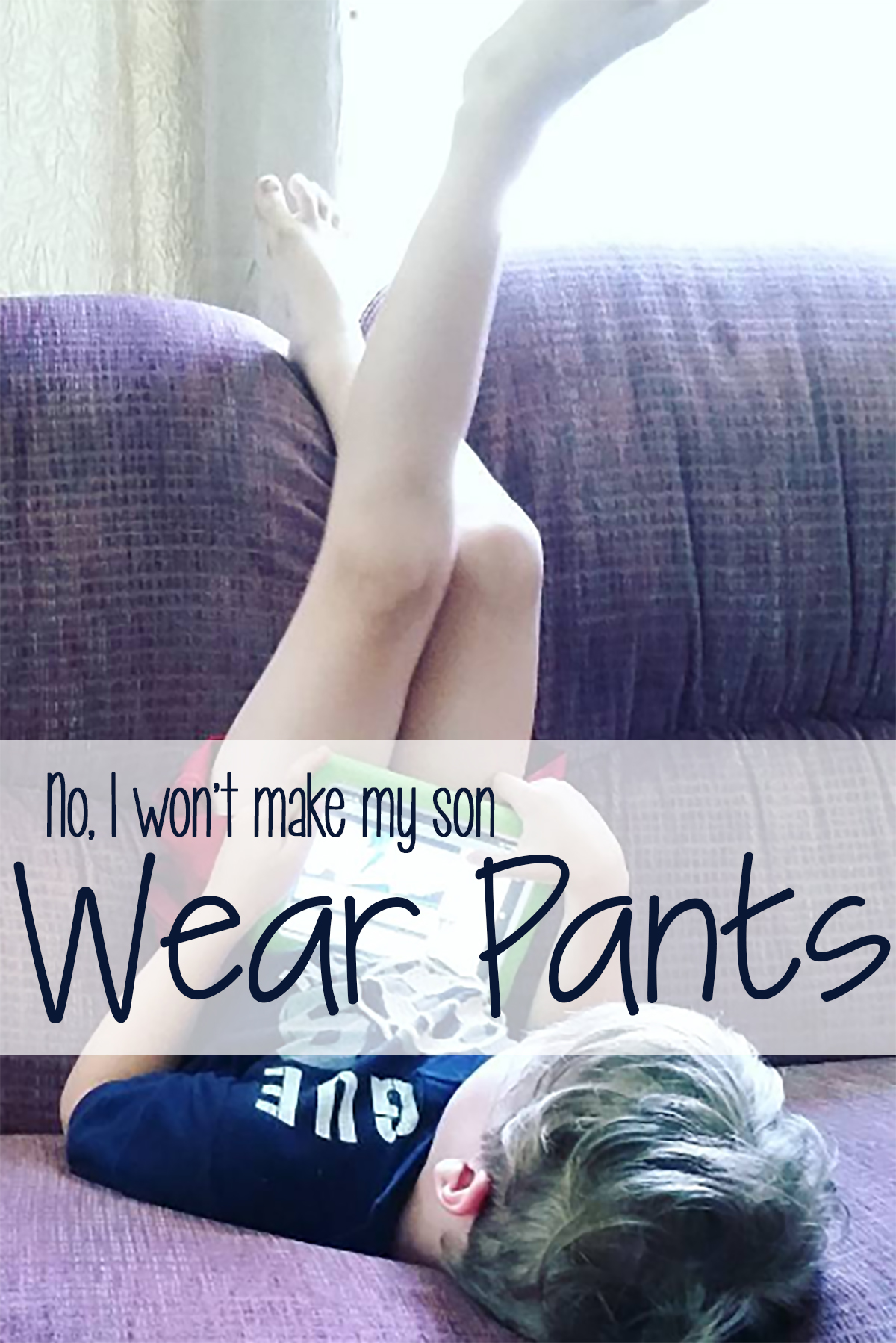
“Well, I thought he was fully dressed until I saw his legs.”
“Isn’t he cold like that?”
“Does he ever wear pants?”
I’ve seen all of the comments. I’ve listened to everything that’s been said. And you know what? No, I’m not making my son, who has clothing sensitivity as a result of autism and sensory processing disorder, wear pants when he’s at home. I’ve got a few reasons.
It’s his body.
I ask my son a few times a day “Hey, you cold? I’ve got some pants here if you want them.” “Nah, mom, I’m warm.” If he doesn’t feel cold, then I’m not making him wear pants. We are very blessed to live in a home with good heat, and he doesn’t seem to have an issue, so why would I?
Think about it: you’re comfortable, but someone keeps trying to come in and make you put on a sweater. You don’t feel like you need it– in fact, you’re just fine– but they insist and insist and insist that you wear the sweater. You may start to second-guess yourself, and your awareness of your body, if everyone insists you feel cold when you don’t, and eventually you take the sweater. But then you feel uncomfortable and hot… so you just end up getting a little grumpy. This is what clothing sensitivity is like– wearing an itchy sweater, even if it’s the softest cotton. Because it is incredibly uncomfortable for my son, if he doesn’t feel cold, and if it’s truly not cold in the house, then I’m not forcing the issue. He knows his body better than I do.
He has enough stimulation.
Zack is constantly stimulated, it seems. Noise, light, family members, the dogs, touch, taste… it’s all stimulating. The feeling of pants can be quite overstimulating. Struggling with pulling them up and down can make it harder for him to get to and from the restroom with ease. Little things can push him over the edge, into meltdown mode, and pants just add that extra stimulus that he doesn’t really need. He wears undies and adding in one more thing, something that will brush against his ankles and graze his legs and make it hard for him to focus on whatever he’s doing… well, it’s just the perfect storm for him to feel crummy. Clothing sensitivity, when added to existing stimulation, or even on it’s own, can cause a child to melt down. Why cause a meltdown when you don’t have to?
He needs to feel confident that he’s safe to express himself at home.
Home is a sanctuary. I guarantee every person in the world has some things that they do at home that they wouldn’t do when they’re out and about. Maybe at home, you choose not to wear shoes. Or, maybe at home, you pick your nose (shhh, I won’t tell). Heck, maybe at home, you belch out loud and don’t say “excuse me.” At home, we can be our truest versions of ourselves, and for Zack, that version of himself, that true essence of who he is, is pantsless. And that’s okay. At home, he can be that person. We certainly aren’t judging him. (Heck, half the time, we’re joining him). Not forcuing him to wear pants is a way to tell him that I am empathetic to his clothing sensitivity.
I make him wear him when we go somewhere.
Trips to the park? The aquarium? Doctor’s appointments? Long drives? Vacations? You better bet this kid has pants on. Of course, we’ve taken care to shop for pants that are comfortable (he won’t wear jeans or khakis, and if they have a snap, forget it), that he can wear without feeling constrained, but if we’re going somewhere, he’s got pants on. When I was making him wear pants all the time, it was a fight to put them on when we went somewhere. Now that I let him exercise that freedom at home, he’s happy (and a lot less argumentative about wearing pants when he goes out). It gives him freedom over his clothing sensitivity when he can have it, and we do our best to work around his clothing sensitivity by choosing clothes he feels comfortable wearing when he needs to be fully clothed.
He’s not hurting anyone.
My kid isn’t melting ladybugs with a magnifying glass. He’s not spitting at neighborhood kids. My son definitely isn’t leaving his dog’s poop in someone else’s yard. You’re not going to catch him doing anything that negatively impacts anyone, generally. He’s even wearing underwear! He’s just simply choosing not to wear pants at home, and that’s okay.
Yeah, maybe someday my kid is going to grow up and create his own nudist colony or clothing-optional community for people with clothing sensitivity. Maybe he’ll stay pantless at home. Maybe he’ll become someone obsessed with pants and decide to wear them 24/7. I really don’t know what the future holds. But for right now, I think it’s important that he feels confident, comfortable, and okay to be who he truly is at home. Even if that means he’s not wearing pants.
So I assure you before you comment on that Facebook photo or mention it to me at the grocery store how you saw a picture of him playing LEGO and he was just in boxers, I know. I know he’s not wearing pants. I know it’s not what you might allow your kids to do. But this is one of those things that I feel the need to let my son do, and I really, really appreciate it when you respect that. If you do, I won’t say a word about how weird it is that your kid is wearing pants when I comment on your Facebook photos. Promise.
More from MamaPlusOne on Autism and Sensory Processing Disorder
When I Tell You About My Son’s Autism Diagnosis, Please Don’t Apologize.
Sometimes Raising a Child With Autism Is Like Raising the Incredible Hulk.
DIY Sensory Calming Board
Effective Parenting During Your Child’s Meltdowns
More Resources About Clothing Sensitivity
10 Tips for Dressing a Sensory Sensitive Child from FriendshipCircle
6 Clothing Solutions for Kids with Sensory Processing Issues from Understood.org
Understanding Temperament: Sensory Sensitivity from The Center for Parenting Education
The Out-Of-Sync Child: Recognizing and Coping With Sensory Processing Disorder by Carol Kranowitz (affiliate link)
Everyday Games for Sensory Processing Disorder by Barbara Sher (affiliate link)
*Author note: No, I’m not posting naked pictures of my son on social media. He’s clothed. He’s just not wearing pants.
MamaPlusOne is a participant in the Amazon Affiliate Program.




